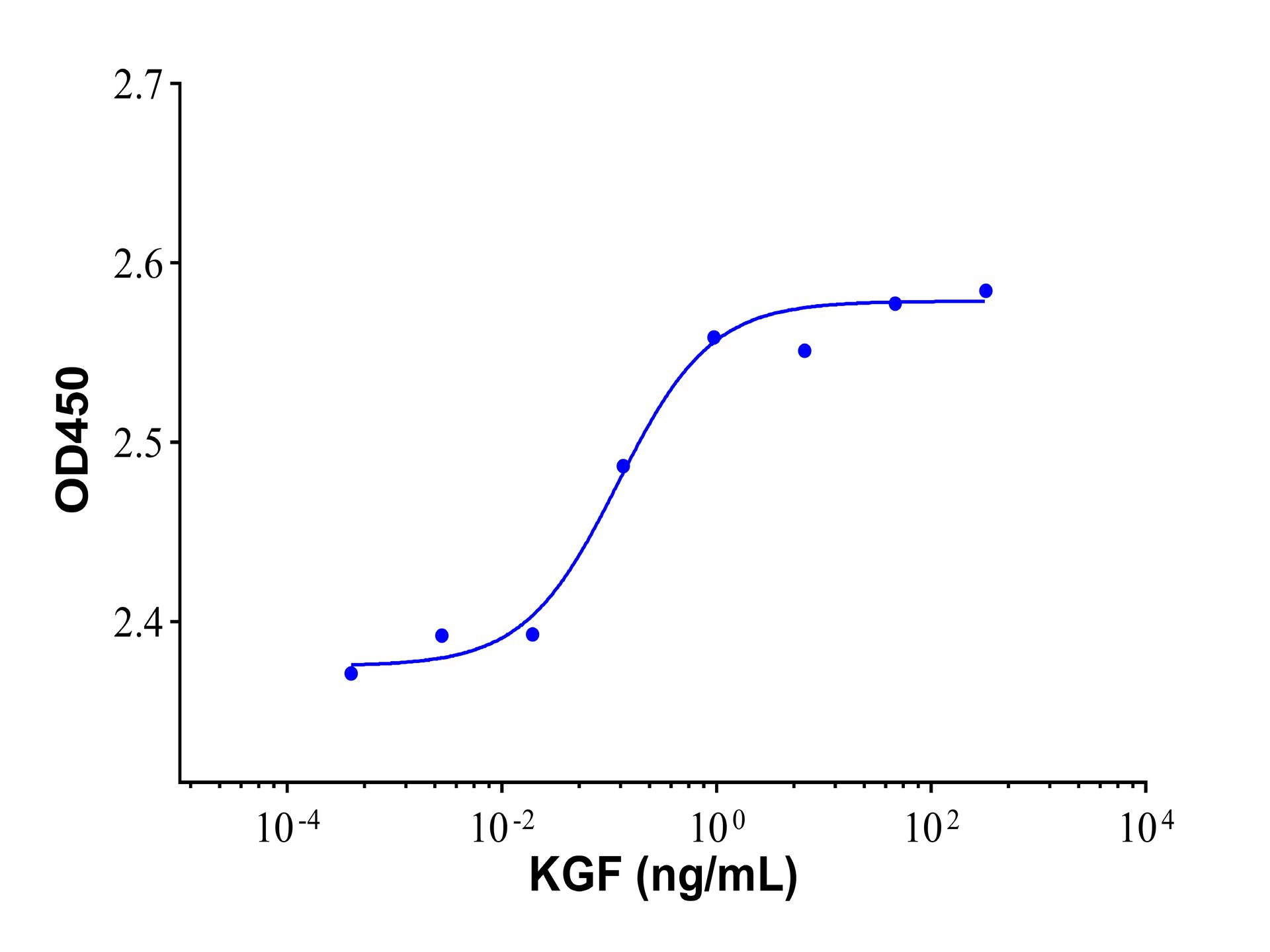Determine the necessary mass, volume, or concentration for preparing a solution.
This is a demo store. No orders will be fulfilled.
| SKU | Size | Availability | Price | Qty |
|---|---|---|---|---|
| rp156342-10μg | 10μg | Available within 4-8 weeks(?) Items will be manufactured post-order and can take 4-8 weeks. Thank you for your patience! | $189.90 | |
| rp156342-50μg | 50μg | Available within 4-8 weeks(?) Items will be manufactured post-order and can take 4-8 weeks. Thank you for your patience! | $619.90 | |
| rp156342-100μg | 100μg | Available within 4-8 weeks(?) Items will be manufactured post-order and can take 4-8 weeks. Thank you for your patience! | $999.90 | |
| rp156342-1mg | 1mg | Available within 8-12 weeks(?) Production requires sourcing of materials. We appreciate your patience and understanding. | $4,599.90 |
Carrier Free, >90% (SDS-PAGE), E.coli, No tag, 32-194 aa
| Product Name | Recombinant Human KGF/FGF-7 Protein, >90% (SDS-PAGE), high purity |
|---|---|
| Synonyms | FGF7 | Fibroblast growth factor 7 | FGF-7 | HBGF-7 | HBGF7 | Heparin-binding growth factor 7 | Keratinocyte growth factor | KGF | FGF-7 | HBGF-7 | Heparin-binding growth factor 7 | Keratinocyte growth factor |
| Grade | ActiBioPure™, Azide Free, Bioactive, Carrier Free, High Performance |
| Product Description | Purity: >90%, by SDS-PAGE visualized with Coomassie® Blue Staining. |
| Specifications & Purity | Carrier Free, Azide Free, Bioactive, ActiBioPure™, High performance, ≥90%(SDS-PAGE) |
| Purity | >90% (SDS-PAGE) |
| Bioactivity | Measured in a cell proliferation assay using MCF-7. The ED50 for this effect is typically <2.0 ng/mL. |
| Endotoxin Concentration | <1.0 EU/μg |
| Expression System | E. coli |
| Species | Human |
| Amino Acids | 32-194 aa |
| Sequence | CNDMTPEQMATNVNCSSPERHTRSYDYMEGGDIRVRRLFCRTQWYLRIDKRGKVKGTQEMKNNYNIMEIRTVAVGIVAIKGVESEFYLAMNKEGKLYAKKECNEDCNFKELILENHYNTYASAKWTHNGGEMFVALNQKGIPVRGKKTKKEQKTAHFLPMAIT |
| Protein Tag | No tag |
| Accession # | P21781 |
| Predicted molecular weight | 18.97 kDa |
| SDS-PAGE | 18.4 kDa, reducing conditions; 17.4 kDa, non-reducing conditions |

Recombinant Human KGF/FGF-7 Protein (rp156342) - Protein Bioactivity
Measured in a cell proliferation assay using MCF-7 cells. The ED₅₀ for this effect is typically < 2.0 ng/mL.

Recombinant Human KGF/FGF-7 Protein (rp156342) - SDS-PAGE
3 μg/lane of Recombinant Human KGF FGF-7 Protein was resolved with SDS-PAGE under reducing (R) and non-reducing (N) conditions and visualized by Coomassie® Blue staining. Showing a band at 18.4 kDa under reducing conditions and 17.4 kDa under non-reducing conditions.
| Shape | Lyophilized |
|---|---|
| Reconstitution | We recommend that this vial be briefly centrifuged prior to opening to bring the contents to the bottom. Reconstitute at 0.5 mg/mL in sterile distilled water. Stock solutions should be apportioned into working aliquots and stored at ≤ -20 °C. Further dilutions should be made in appropriate buffered solutions. |
| Storage Temp | Store at -20°C,Avoid repeated freezing and thawing |
| Shipped In | Ice chest + Ice pads |
| Stability And Storage | Store at -20°C for 1 year, store at 2-8℃ for 1 month. Avoid freeze / thaw cycle. |
Find and download the COA for your product by matching the lot number on the packaging.
| Lot Number | Certificate Type | Date | Item |
|---|---|---|---|
| Certificate of Analysis | Jul 21, 2023 | rp156342 | |
| Certificate of Analysis | Jul 20, 2023 | rp156342 | |
| Certificate of Analysis | Jul 20, 2023 | rp156342 |

Starting at $139.90
| 1. Aaronson, S A SA and 8 more authors.. (1991) Keratinocyte growth factor. A fibroblast growth factor family member with unusual target cell specificity.. Annals of the New York Academy of Sciences, [PMID:1664700] |
| 2. Finch, P W PW, Rubin, J S JS, Miki, T T, Ron, D D and Aaronson, S A SA.. (1989) Human KGF is FGF-related with properties of a paracrine effector of epithelial cell growth.. Science (New York, N.Y.), (18): [PMID:2475908] |
| 3. Rubin, J S JS and 5 more authors.. (1989) Purification and characterization of a newly identified growth factor specific for epithelial cells.. Proceedings of the National Academy of Sciences of the United States of America, [PMID:2915979] |
| 4. Beer, Hans-Dietmar HD and 6 more authors.. (2005) The fibroblast growth factor binding protein is a novel interaction partner of FGF-7, FGF-10 and FGF-22 and regulates FGF activity: implications for epithelial repair.. Oncogene, (11): [PMID:15806171] |
| 5. Zody, Michael C MC and 68 more authors.. (2006) Analysis of the DNA sequence and duplication history of human chromosome 15.. Nature, (30): [PMID:16572171] |
| 6. Zhang, Xiuqin X and 5 more authors.. (2006) Receptor specificity of the fibroblast growth factor family. The complete mammalian FGF family.. The Journal of biological chemistry, (9): [PMID:16597617] |